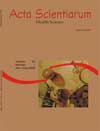Morphologic alterations caused by electro-hydraulic shock waves reapplication in rat kidney
Abstract
Urinary calculus recidives are frequents, needing shock waves multiple applications for its treatment. This research studies acute morphological changes that occur in the kidneys of rats subjected to electro-hydraulic shock waves reapplication. The experiment used 48 rats, divided in four groups of 12. The first group received two 2,000 shock waves applications with 14 kV intensity and a fourteen-day interval between the applications. The third group received only one 2,000 shock waves application of the same intensity. The second and fourth groups were control groups. The kidneys were examined 72 hours after the application, observing: subcapsular, interstitial and glomerular hemorrhage; corticol results showed that electro-hydraulic shock reapplication in the rat kidneys didn’t greater damages than the first application.Downloads
Download data is not yet available.
Published
2008-05-06
How to Cite
Kira, V. M., Ortiz, V., Bandeira, C. O. P., Meister, H., Jorge, J. J., & Ribeiro, S. C. (2008). Morphologic alterations caused by electro-hydraulic shock waves reapplication in rat kidney. Acta Scientiarum. Health Sciences, 23, 691-695. https://doi.org/10.4025/actascihealthsci.v23i0.2911
Issue
Section
Health Sciences
DECLARATION OF ORIGINALITY AND COPYRIGHTS
I Declare that current article is original and has not been submitted for publication, in part or in whole, to any other national or international journal.
The copyrights belong exclusively to the authors. Published content is licensed under Creative Commons Attribution 4.0 (CC BY 4.0) guidelines, which allows sharing (copy and distribution of the material in any medium or format) and adaptation (remix, transform, and build upon the material) for any purpose, even commercially, under the terms of attribution.
Read this link for further information on how to use CC BY 4.0 properly.























5.png)







